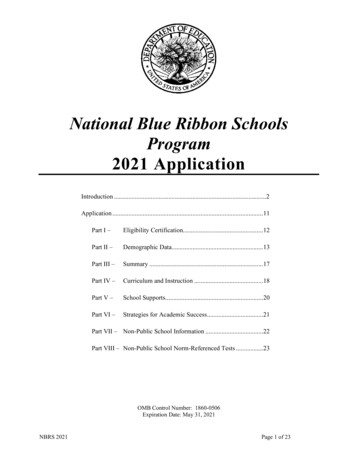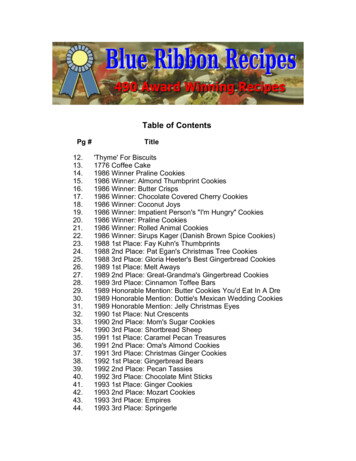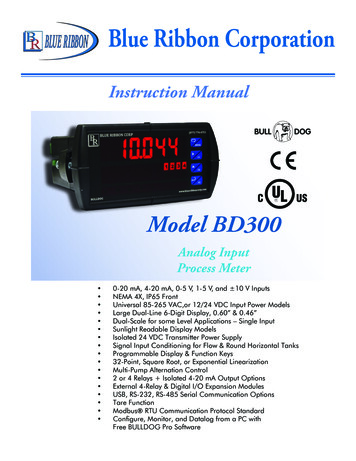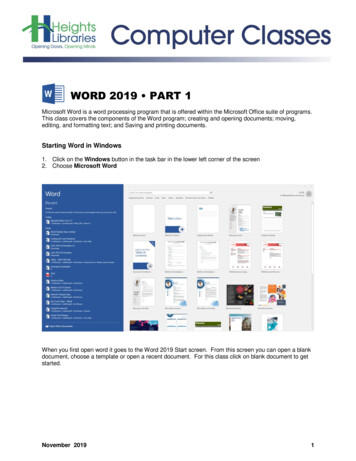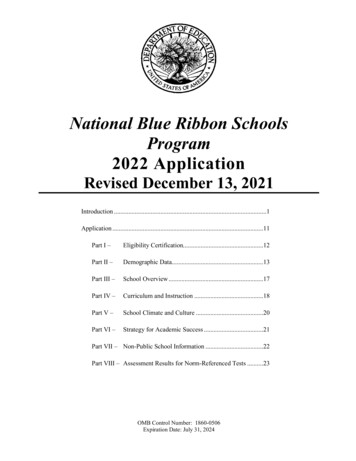
Transcription
National Blue Ribbon SchoolsProgram2022 ApplicationRevised December 13, 2021Introduction .1Application .11Part I –Eligibility Certification.12Part II –Demographic Data.13Part III –School Overview .17Part IV –Curriculum and Instruction .18Part V –School Climate and Culture .20Part VI –Strategy for Academic Success .21Part VII – Non-Public School Information .22Part VIII – Assessment Results for Norm-Referenced Tests .23OMB Control Number: 1860-0506Expiration Date: July 31, 2024
2022 National Blue Ribbon Schools ProgramA National Recognition Program for American SchoolsSince 1982, the U.S. Department of Education’s National Blue Ribbon Schools Program has honoredAmerica’s most successful public and non-public elementary, middle, and high schools. A National BlueRibbon Schools flag waving overhead has become a trademark of excellence, a symbol of qualityrecognized by everyone from parents to policy-makers in thousands of communities.The National Blue Ribbon Schools Program recognizes 1) schools whose students achieve at very highlevels or 2) schools making significant progress in closing achievement gaps among different groups ofstudents. The Program sets a standard of excellence for all schools striving for the highest level ofachievement.National Blue Ribbon Schools are honored each year at a recognition ceremony in Washington, DC. Theapplications from the award-winning schools are posted on the Department’s website. A small group ofNational Blue Ribbon Schools are visited each year to highlight educational practices that have beenespecially successful.Public School Nomination ProcessFor public schools, the Secretary invites Chief State School Officers (CSSOs), including the District ofColumbia (DC), Puerto Rico, the Virgin Islands, the Department of Defense Education Activity (DoDEA),and the Bureau of Indian Education (BIE), to nominate schools. In this document, the title CSSO will referto the chief school officers in the states and in the public education entities named above.In submitting the list of nominated schools, CSSOs must certify that the schools meet the minimumrequirements established by the Department for nomination. As described below, CSSOs must also rely ontheir own education accountability and assessment systems to identify schools for submission to theSecretary.Disadvantaged Backgrounds of Students. At least one-third of the public schools nominated by each statemust be schools with a high percentage of students from disadvantaged backgrounds. A student from a“disadvantaged background” is defined by the CSSO of each state. The definition may include economicallydisadvantaged students, that is, students who are eligible for free and reduced-price school meals; studentswith disabilities; students who are limited English proficient; migrant students; and/or students receivingservices under Title I of the Elementary and Secondary Education Act, as amended by the Every StudentSucceeds Act of 2015. Each state may set the percentage that defines “high percentage.” TheDepartment also recommends nominated schools reflect the demographic and geographic diversity of thestate’s school-age population.Each state’s nomination criteria must pertain equally to all public schools nominated by the state.A school may be nominated in either of two performance award categories: Exemplary High Performing orExemplary Achievement Gap Closing. The student performance criteria that a school must meet in order tobe nominated in each of these two categories are described below.1) Exemplary High Performing Schools. “High performing” is defined by the CSSO of each state, butat a minimum means that the school meets the performance criteria summarized in the followingtable:1
CriterionThreshold1a. Whole SchoolPerformanceTop 15%in the State1b. SchoolSubgroupPerformanceTop 40%in the Statefor EachSubgroup1c. High SchoolGraduationRate andoptional CCRMeasureTop 15%in the StateMeasure for Ranking SchoolsOption 1Option 2Option 3Reading\ELAReading\ELAComposite Scoreand Mathand aratelyCombinedMath, and OtherMeasuresReading\ELAReading\ELAComposite Scoreand Mathand aratelyCombinedMath, and OtherMeasuresGraduation Rate Graduation Rate Composite Scoreand optionaland optionalCombiningCCR MeasureCCR MeasureGraduation RateSeparatelyCombinedand optionalCCR MeasurewithReading/ELA,Math and OtherMeasures1a. Whole School Performance. All schools are ranked 1 based on the performance of all studentsin the school on the most recently administered state assessments in reading (or Englishlanguage arts) and mathematics. 2 The most recently administered assessments may be from the2020-2021 school year, the 2018-2019 school year, or both. Results for 2020-2021 may be usedonly if each school had a high participation rate. Basing results on assessments from both yearscould, for example, be an average of school performance from both years, or using the 20182019 results when the 2020-2021 results are missing or are based on a low participation rate.The state may rank schools on these two subjects separately or rank schools on the two subjectscombined (e.g., sum or average). The state may also combine performance on theseassessments with other measures of student performance (e.g., student growth on stateassessments, performance on state assessments in other subjects, graduation rates, or otherindicators in the state’s accountability system) and rank the schools on the resulting compositescore/index. Schools in the top 15 percent of each ranking for reading/ELA and mathematics(separately, combined, or as part of a composite score/index) meet the threshold for thiscriterion.1b. School Subgroup Performance. For each of the state’s subgroups, 3 all schools are rankedbased on the performance of the students in that subgroup on the most recently administeredstate assessments in reading (or English language arts) and mathematics (separately, combined,or as part of a composite score/index). The most recently administered assessments must be thesame as those used for ranking whole school performance in 1a (the 2020-2021 school year, the2018-2019 school year, or both). Results for 2020-2021 may be used only if each school had ahigh participation rate for each sufficiently large subgroup. 4 Schools in the top 40 percent ofeach ranking for each of their sufficiently large subgroups meet the threshold for this criterion.The state may rank schools based on all grades served or rank schools separately for different grade spans or grades.This includes students tested with accommodations.3States are encouraged to nominate schools based on the performance of the subgroups included in their accountabilitysystem.4A “sufficiently large subgroup” is one that meets the minimum “n-size” for subgroups in the state’s accountabilitysystem.122
1c. High School Graduation Rate. All high schools are ranked based on the state’s most recentgraduation rate (2020-2021, 2019-2020, or 2018-2019) and, optionally, on the most recentmeasure of CCR (separately, combined, or as part of a composite score/index).5 High schoolsin the top 15 percent of each ranking meet the threshold for this criterion.2) Exemplary Achievement Gap Closing Schools: “Achievement gap closing” is defined by the CSSOof each state, but at a minimum means that the school meets the performance criteria summarized inthe following table:CriteriaThreshold2a. SchoolSubgroupImprovementTop 15% inthe State forOne or MoreSubgroups2b. SchoolSubgroupPerformanceTop 40% inthe State forEachSubgroup2c. High SchoolSubgroupGraduationRate andoptional CCRMeasureTop 40% inthe State forEachSubgroup2d. WholeSchoolImprovementEquals orExceedsWhole StateImprovementMeasure for Ranking SchoolsOption 1Option 2Option 3Improvement in Improvement in Improvement inReading\ELAReading\ELAComposite Scoreand Mathand MathCombiningSeparatelyCombinedReading\ELA,Math, and OtherMeasuresReading\ELAReading\ELAComposite Scoreand Mathand aratelyCombinedMath, and OtherMeasuresGraduation Rate Graduation Rate Composite Scoreand optionaland optionalCombiningCCR MeasureCCR MeasureGraduation RateSeparatelyCombinedand optionalCCR MeasurewithReading/ELA,Math and OtherMeasuresImprovement in Improvement in Improvement inReading\ELAReading\ELAComposite Scoreand Mathand MathCombiningSeparatelyCombinedReading\ELA,Math, and OtherMeasures2a. School Subgroup Improvement. For each of the state’s subgroups, 6 all schools are rankedbased on the increase in the performance of that subgroup on the most recently administeredstate assessments (2020-2021, 2018-2019, or both) in reading (or English language arts) andmathematics (separately, combined, or as part of a composite score/index), comparing theresults for the most recent school year in which the state assessments were administered to theresults for the school year 2-4 years before. Results for 2020-2021 may be used only if eachschool had a high participation rate for each sufficiently large subgroup. Schools in the top 15percent of each ranking for at least one of their sufficiently large subgroups 7 meet thethreshold for this criterion.If a state uses a composite in 1a that includes graduation rate and optional CCR measure(s) for ranking high schools,their composite scores may be identical to their composite scores used in 1c.6States are encouraged to nominate schools based on the performance of the subgroups included in their accountabilitysystem.57A “sufficiently large subgroup” is one that meets the minimum “n-size” for subgroups in thestate’s accountability3
2b. School Subgroup Performance. For each of the state’s subgroups, all schools are rankedbased on the performance of the students in that subgroup on the most recently administeredstate assessments in reading (or English language arts) and mathematics (separately, combined,or as part of a composite score/index). The most recently administered assessments must be thesame as those used for ranking subgroup performance in 2a (the 2020-2021 school year, the2018-2019 school year, or both). Results for 2020-2021 may be used only if each school had ahigh participation rate for each sufficiently large subgroup Schools in the top 40 percent of eachranking for each of their sufficiently large subgroups meet the threshold for this criterion.2c. High School Subgroup Graduation Rate. For each of the state’s subgroups, all high schoolsare ranked based on the state’s most recent graduation rate (2020-2021, 2019-2020, or 20182019) and, optionally, on the most recent measure of CCR (separately, combined, or as part of acomposite score/index). High schools in the top 40 percent of this ranking for each of theirsufficiently large subgroups meet the threshold for this criterion.2d. Whole School Improvement. In order for a school to meet the threshold for this criterion, theincrease in the performance of all students in the school on the most recently administered stateassessments in reading (or English language arts) and mathematics (separately, combined, or aspart of a composite score/index), comparing the results for the most recent school year in whichthe state assessments were administered to the results for the school year 2-4 years before, mustequal or exceed the increase in the performance of all public school students in the state over thesame period.In addition to meeting the above student performance requirements, a nominated school must, in most cases,have at least 100 students enrolled and have assessment data for at least 10 students in each tested grade forboth reading (or English language arts) and mathematics. States with a large percentage of schools withfewer than 100 students enrolled may include up to a similar percentage of these schools in theirnominations. However, these schools must have assessment data for at least 10 students in each tested gradefor both reading (or English language arts) and mathematics.All nominated public schools must meet the state’s goals for interim progress in the state accountabilitysystem or other performance targets that are set by the state for the school year in question in at least reading(or English language arts), mathematics, graduation rates, and possibly other academic indicators, for the allstudents group. Additionally, nominated schools must have high assessment participation rates, using themost recent accountability results available, for the all students group. Finally, in order to meet all schoolperformance eligibility requirements, all nominated public schools must be certified by the state prior to theSeptember 2022 announcement of National Blue Ribbon Schools by the U. S. Secretary of Education.Other Eligibility Requirements for Public National Blue Ribbon Schools1. The school configuration must include one or more of grades K-12. Schools located on the samecampus (physical location and mailing address) must apply as an entire school (i.e. K-8; 6-12; K-12school). Two (or more) schools located on separate campuses, must apply individually even if theyhave the same principal. A single school located on multiple campuses with one principal must applyas an entire school.2. The school has been in existence for five full years, that is, from at least September 2017 and gradesparticipating in statewide assessments must have been part of the school for at least the three yearsprior to September 2021.3. The nominated school has not received the National Blue Ribbon Schools award in the past five years:2017, 2018, 2019, 2020, or 2021.4.The nominated school has no history of testing irregularities, nor have charges of irregularities beenbrought against the school at the time of nomination. If irregularities are later discovered and provenby the state, the U.S. Department of Education reserves the right to disqualify a school’s applicationand/or rescind a school’s award.4
5. The nominated school has not been identified by the state as “persistently dangerous” within the lasttwo years.6. The nominated school or district is not refusing Office of Civil Rights (OCR) access to informationnecessary to investigate a civil rights complaint or to conduct a district-wide compliance review.7. The OCR has not issued a violation letter of findings to the school district concluding that thenominated school or the district as a whole has violated one or more of the civil rights statutes. Aviolation letter of findings will not be considered outstanding if OCR has accepted a corrective actionplan from the district to remedy the violation.8. The U.S. Department of Justice does not have a pending suit alleging that the nominated school or theschool district as a whole has violated one or more of the civil rights statutes or the Constitution’sequal protection clause.9. The nominated school has, or is subject to, a nondiscrimination policy (provide either a link to thepolicy or submit a text of the policy), is committed to equal opportunity for all students and all staffconsistent with applicable law and does not have any outstanding findings of unlawful discrimination.The U.S. Department of Education reserves the right to disqualify a school’s nomination and/orrescind a school’s award if unlawful discrimination is later discovered.10. There are no findings of violations of the Individuals with Disabilities Education Act in a U.S.Department of Education monitoring report that apply to the school or school district in question; or ifthere are such findings, the state or district has corrected, or agreed to correct, the findings.The U.S. Department of Education reserves the right to disqualify a school’s nomination and/orrescind a school’s award if one of these eligibility requirements is later discovered to have not beenmet or otherwise violated.Once the Secretary receives the nominations from the CSSOs, nominated schools are invited to submitapplications for recognition as National Blue Ribbon Schools.Non-Public School Nomination ProcessFor not-for-profit non-public schools, the Secretary invites the Council for American Private Education(CAPE) to nominate schools that meet the criteria for recognition. Non-public schools interested in applyingfor nomination should contact the Council for American Private Education directly. CAPE must ensure andcertify that the schools meet the criteria before submitting nominations to the Department.Non-public schools are eligible for National Blue Ribbon recognition if they meet the following criteria:1) Exemplary High Performing Schools: “High performing” means:(a) that the achievement of the school’s students in the most recently completed school year testedplaces the school in the top 15 percent in the nation in reading (or English language arts) andmathematics as measured by a nationally normed test or in the top 15 percent of its state asmeasured by a state test. If a non-public school administers both state test and nationally normedtests, the school must be in the top 15 percent for both tests.(b) Disaggregated results for student groups, including students from disadvantaged backgrounds,must be similar to the results for all students tested.(c) For the most recent year in which graduation rates are available, the graduation rate for nonpublic high schools must be 95% or higher.A student from a “disadvantaged background” may include economically disadvantaged students, that is,students who are eligible for free and reduced-price school meals; students with disabilities; students whoare limited English proficient; migrant students; and/or students receiving services under Title I of theElementary and Secondary Education Act, as amended by the Every Student Succeeds Act of 2015.5
Other Eligibility Requirements for Non-Public National Blue Ribbon Schools1. The school configuration must include one or more of grades K-12. Schools located on the samecampus (physical location and mailing address) must apply as an entire school (i.e. K-8; 6-12; K-12school). Two (or more) schools located on separate campuses, must apply individually even if theyhave the same principal. A single school located on multiple campuses with one principal must applyas an entire school.2. The school has been in existence for five full years, that is, from at least September 2017 and gradesparticipating in statewide assessments must have been part of the school for at least the three yearsprior to September 2021.3. The nominated school has not received the National Blue Ribbon Schools award in the past five years:2017, 2018, 2019, 2020, or 2021.4.The nominated school has no history of testing irregularities, nor have charges of irregularities beenbrought against the school at the time of nomination. If irregularities are later discovered and provenby the state, the U.S. Department of Education reserves the right to disqualify a school’s applicationand/or rescind a school’s award.5. The nominated school has not been identified by the state as “persistently dangerous” within the lasttwo years.6. The nominated school or district is not refusing Office of Civil Rights (OCR) access to informationnecessary to investigate a civil rights complaint or to conduct a district-wide compliance review.7. The OCR has not issued a violation letter of findings to the school district concluding that thenominated school or the district as a whole has violated one or more of the civil rights statutes. Aviolation letter of findings will not be considered outstanding if OCR has accepted a corrective actionplan from the district to remedy the violation.8. The U.S. Department of Justice does not have a pending suit alleging that the nominated school or theschool district as a whole has violated one or more of the civil rights statutes or the Constitution’sequal protection clause.9. The nominated school has, or is subject to, a nondiscrimination policy (provide either a link to thepolicy or submit a text of the policy), is committed to equal opportunity for all students and all staffconsistent with applicable law and does not have any outstanding findings of unlawful discrimination.The U.S. Department of Education reserves the right to disqualify a school’s nomination and/orrescind a school’s award if unlawful discrimination is later discovered.10. There are no findings of violations of the Individuals with Disabilities Education Act in a U.S.Department of Education monitoring report that apply to the school or school district in question; or ifthere are such findings, the state or district has corrected, or agreed to correct, the findings.The U.S. Department of Education reserves the right to disqualify a school’s nomination and/orrescind a school’s award if one of these eligibility requirements is later discovered to have not beenmet or otherwise been violated.For information on the nomination process and timeline for CAPE, non-public schools representativesshould consult the Council for American Private Education Website.6
Public and Non-Public Nomination Allocations and Eligibility for Public andNon-Public SchoolsStates and public entities, including DC, Puerto Rico, the Virgin Islands, BIE, and DoDEA, are allocated anumber of National Blue Ribbon School nominations based on total K-12 student enrollment and number ofpublic schools. Allocations range from a minimum of 3 schools to a maximum of 35. CAPE may nominateup to 50 non-public schools. A total of 420 public and non-public schools could be nominated each year.Eligible schools, then, are those submitted by authorized nominators that meet all National Blue RibbonSchools Program criteria and requirements and have completed a comprehensive, high quality applicationaccording to Program timelines.Application Process for Nominated SchoolsOnce the Department receives the nominations from the CSSOs, the Secretary extends an invitation to thenominated schools to apply.The nominators are encouraged to contact principals of selected schools prior to nomination to verifyprincipals’ commitment and to review completed applications prior to submission to ensure that recognizedschools will be outstanding models of excellence for their states and for the National Blue Ribbon SchoolsProgram. The Secretary reserves the right to initiate site visits to schools to document educational practicesas well as to verify the accuracy of data.7
Timeline for 2022 National Blue Ribbon SchoolsDateDueOctober, 2021The Secretary of Education sends a letter of invitation to the CSSOsand CAPE requesting nominations of eligible schools.October, 2021Conduct webinar/TA conference calls to review guidance andapplication with liaisons.December 31, 2021Nomination processes and data for public schools being consideredfor nomination from CSSOs are due to the Department.January 14, 2022Hard copy of non-public school applications are due to CAPE.January 10-14, 2022Nomination processes and data for public schools being consideredfor nomination are reviewed by ED and a NBRS Assessment Panelfor alignment with the general eligibility criteria of the National BlueRibbon Schools Program.February 2, 2022February 7, 2022Approved public school nominations are entered by states into onlineportal.The Department invites public schools nominated by CSSOs to applyfor recognition as National Blue Ribbon Schools.February 18, 2022CAPE selects non-public school nominations.April 8, 2022Completed public and non-public school applications are due to theDepartment.April-June, 2022Applications are reviewed for completeness, quality, and accuracy.August, 2022States certify that nominated public schools have met all eligibilityrequirements.The Secretary of Education announces the 2022 National BlueRibbon Schools (public and non-public).Two representatives from each school, the principal and a teacher,attend the recognition ceremony in Washington, DC.September, 2022November, 2022Important Considerations for Completing the National Blue Ribbon School Online Application1. The entire application must be submitted through the secure online school portal at: National BlueRibbon Schools Program.2. A School ID username and Password are necessary to access the online application form in the secureschool portal.3. Narrative responses to application questions must address the topic succinctly. No attachments to theonline application can be submitted. Bulleted sections are not acceptable.4. Tables, charts, graphs, photos cannot be accommodated by the online application.8
5. Online instructions must be followed when copying/pasting text from Word to the online application;formatting may be changed.6. Saving work frequently is necessary to protect the “work in progress.”7. Printing the application for review is possible before and after the final submission.8. Public and non-public school applicants must convert the original signed cover page of theapplication to a PDF file and upload the PDF via the online application portal.9. All public and non-public school applications must be completed and submitted by Program timelines.No changes can be made to applications after submission.Instructions for completing the application are provided as online help text. Assistance is available forschool applicants through the National Blue Ribbon Schools Technical Assistance Team. For help innavigating the online system, or questions regarding responses to the narrative or data items, use thecontact form located at: National Blue Ribbon Schools Program.9
Paperwork Burden StatementAccording to the Paperwork Reduction Act of 1995, no persons are required to respond to a collection ofinformation unless such collection displays a valid OMB control number. The valid OMB control numberfor this information collection is 1860-0506. The expiration date is 7/31/2024. The time required tocomplete this information collection is estimated to average 39.75 hours per response, including the time toreview instructions, search existing data resources, gather the data needed, and complete and review theinformation collection. If you have any comments concerning the accuracy of the time estimate(s) orsuggestions for improving this form, please write to: U.S. Department of Education, Washington, DC20202-4651. If you have comments or concerns regarding the status of the individual submission of thisform, contact Aba Kumi, (Aba.Kumi@ed.gov) Director, National Blue Ribbon Schools Program, Office ofCommunications and Outreach, U.S. Department of Education, 400 Maryland Ave., SW, Room 5E103,Washington, DC 20202-8173.10
2022 National Blue Ribbon Schools Program[ ] Public or [ ] Non-publicFor Public Schools only: (Check all that apply) [ ] Title I [ ] Charter [ ] Magnet [ ] ChoiceName of Principal(Specify: Ms., Miss, Mrs., Dr., Mr., etc.) (As it should appear in the official records)Official School NameSchool Mailing Address(As it should appear in the official records)(If address is P.O. Box, also include street address.)CityStateZip Code 4 (9 digits total)CountyTelephone ( )Fax ( )Web site/URLE-mailTwitter HandleFacebook PageGoogle YouTube/URLBlogOther Social Media LinkI have reviewed the information in this application, including the eligibility requirements on page 2 (Part IEligibility Certification), and certify, to the best of my knowledge, that it is accurate.Date(Principal’s Signature)Name of Superintendent*E-MailDistrict NameTel.((Specify: Ms., Miss, Mrs., Dr., Mr., Other))I have reviewed the information in this application, including the eligibility requirements on page 2 (Part IEligibility Certification), and certify, to the best of my knowledge, that it is accurate.Date(Superintendent’s Signature)Name of School BoardPresident/Chairperson(Specify: Ms., Miss, Mrs., Dr., Mr., Other)I have reviewed the information in this application, including the eligibility requirements on page 2 (Part IEligibility Certification), and certify, to the best of my knowledge, that it is accurate.(School Board President’s/Chairperson’s Signature)DateThe original signed cover sheet only should be converted to a PDF file and uploaded via the online portal.*Non-public Schools: If the information requested is not applicable, write N/A in the space.11
PART I – ELIGIBILITY CERTIFICATIONThe signatures on the first page of this application (cover page) certify that each of the statements below,concerning the school’s eligibility and compliance with U.S. Department of Education and National BlueRibbon Schools requirements, are true and correct.1. All nominated public and non-public schools must have met the program’s academicrequirements overseen by each state, public entity, and the Council for American PrivateEducation.2. To meet final eligibility, all nominated public schools must be certified by states prior to September2022 in order to meet all eligibility requirements. Any status appeals must be resolved at least twoweeks before the awards ceremony for the school to receive the award.3. The school configuration must include one or more of grades K-12. Schools located on the samecampus (physical location and mailing address) must apply as an entire school (i.e. K-8; 6-12; K-12school). Two (or more) schools located on separate campuses, must apply individually even if they havethe same principal. A single school located on multiple campuses with one principal must apply as anentire school.4. The school has been in existence for five full years, that is
2022 National Blue Ribbon Schools Program A National Recognition Program for American Schools Since 1982, the U.S. Depar tment of Education's National Blue Ribbon Schools Program has honored America's most successful public and non-public elementary, middle, and high schools. A National Blue
